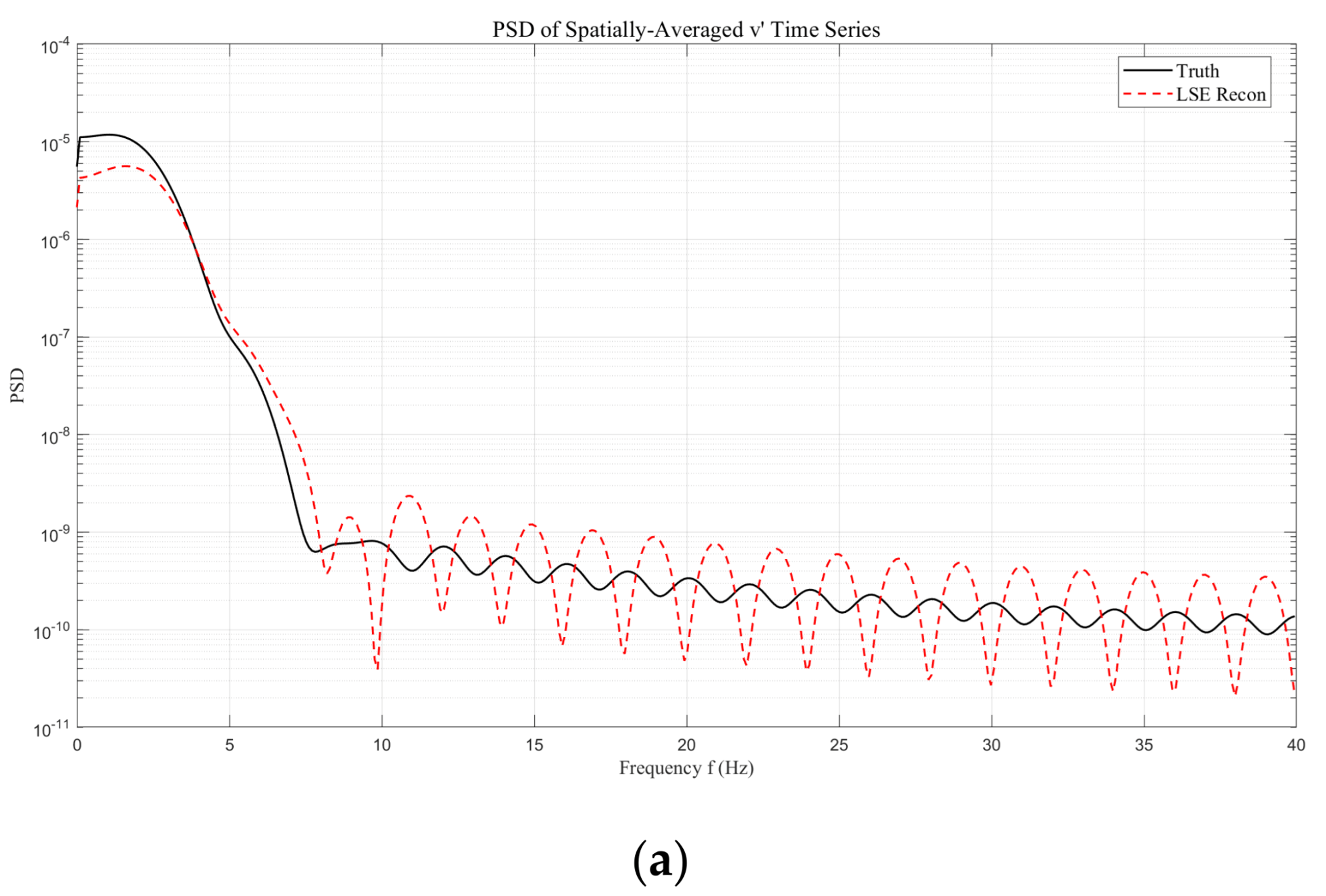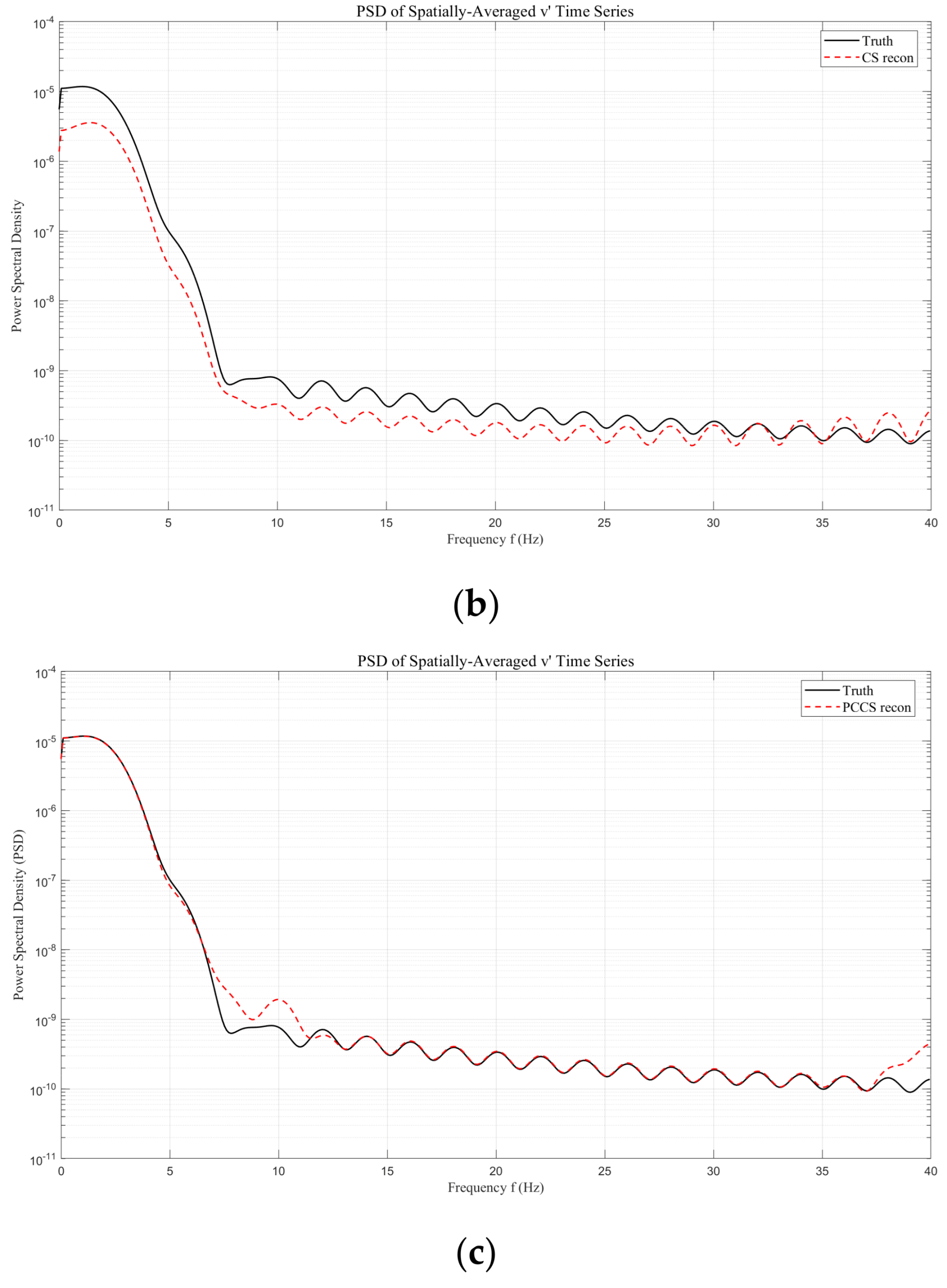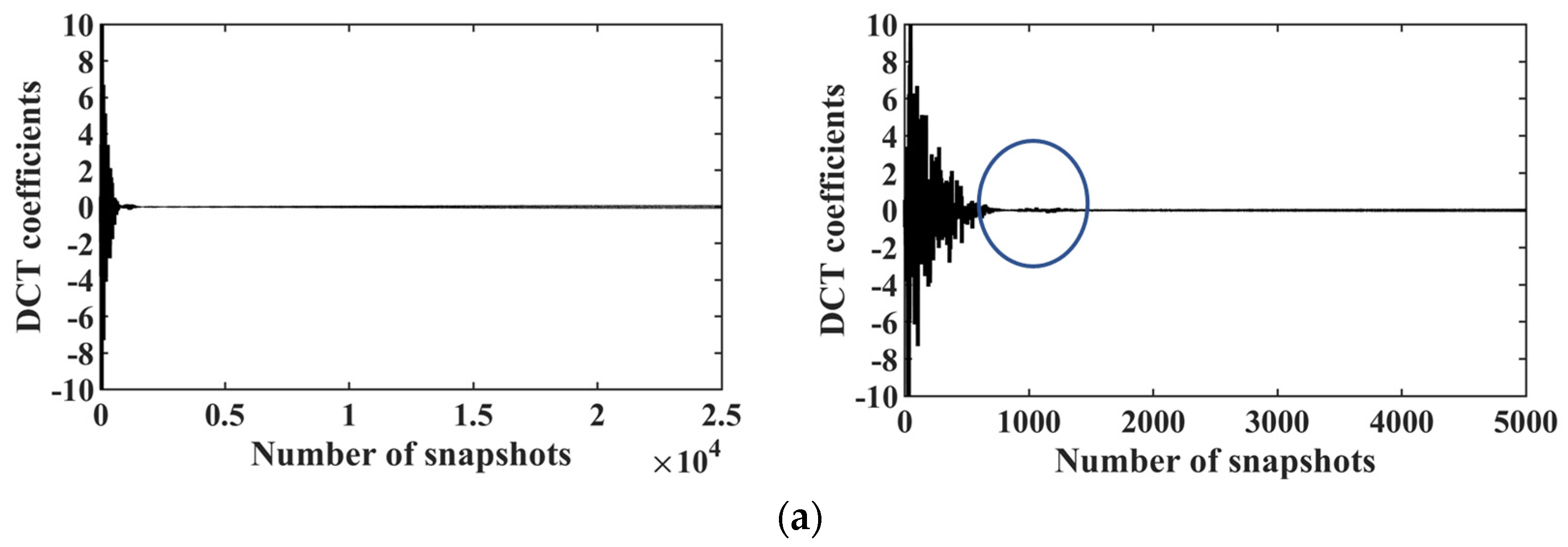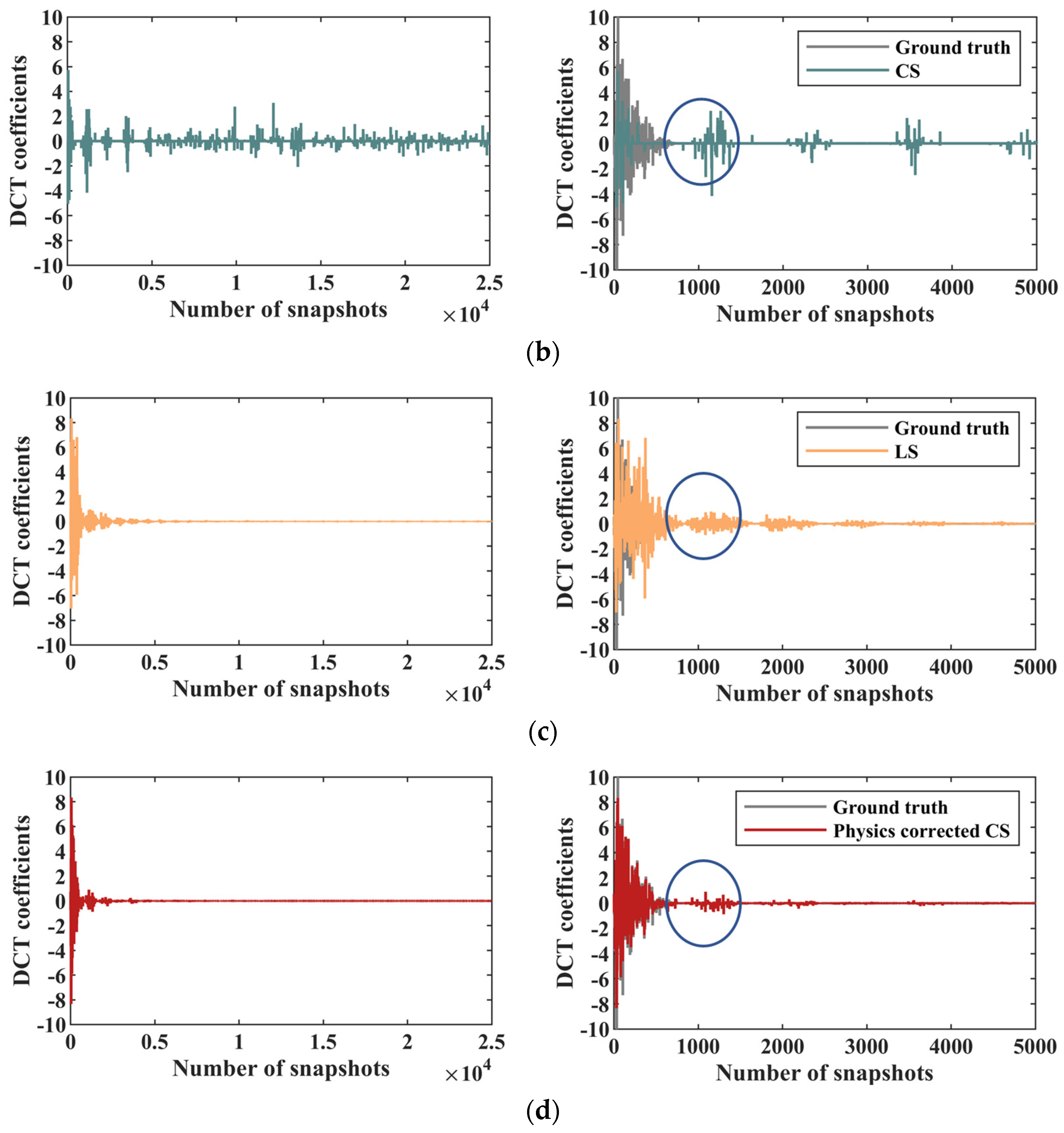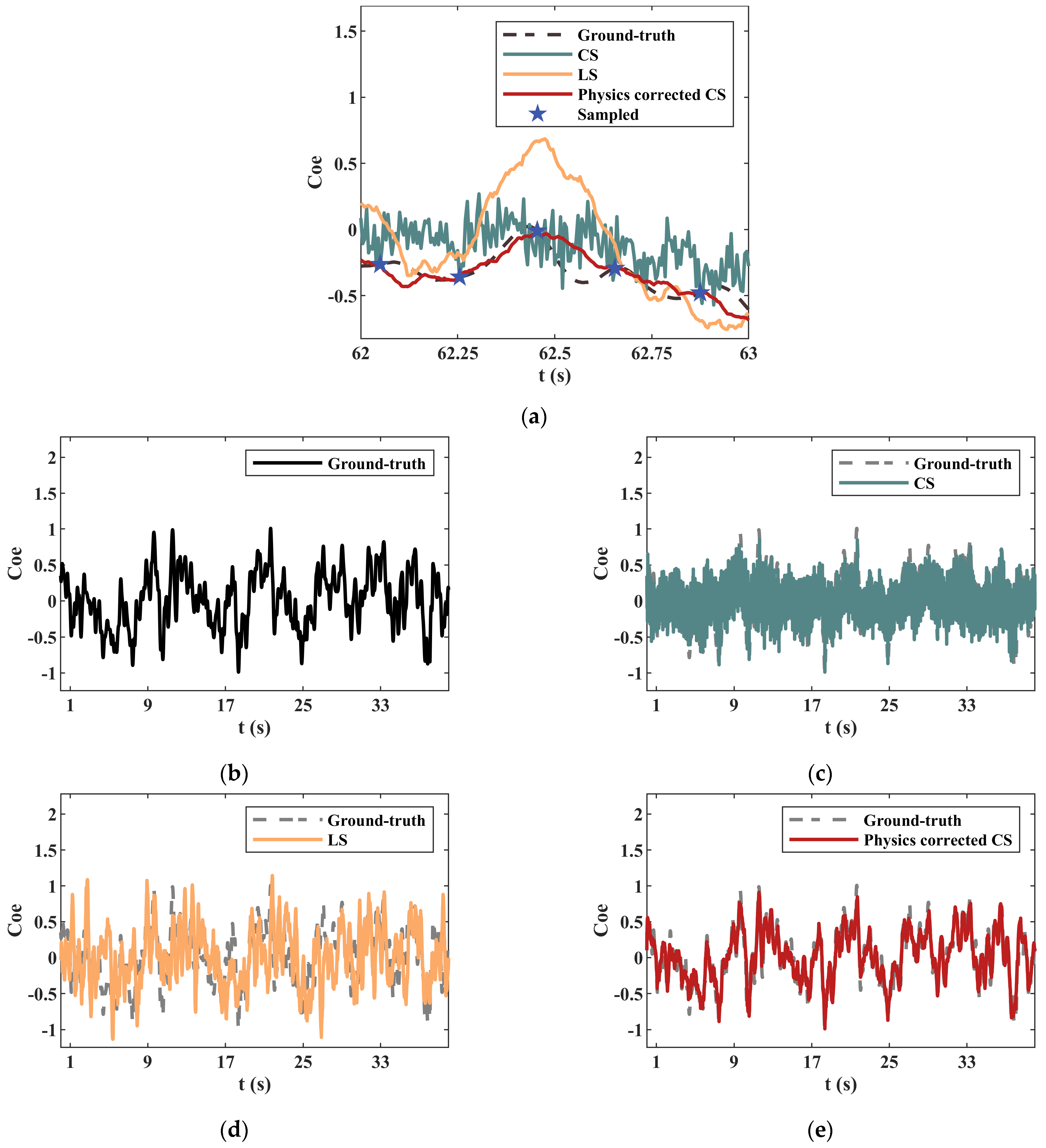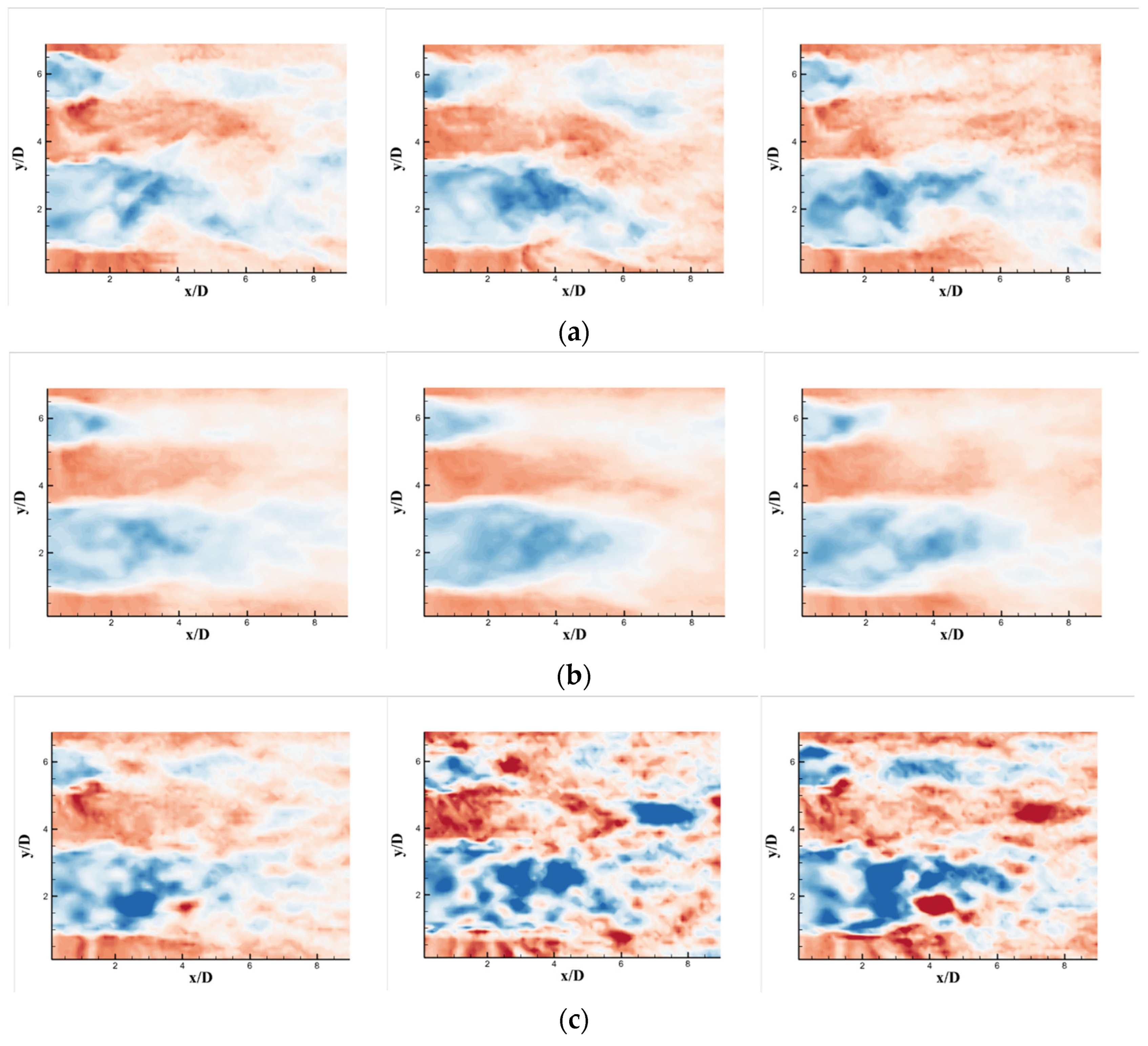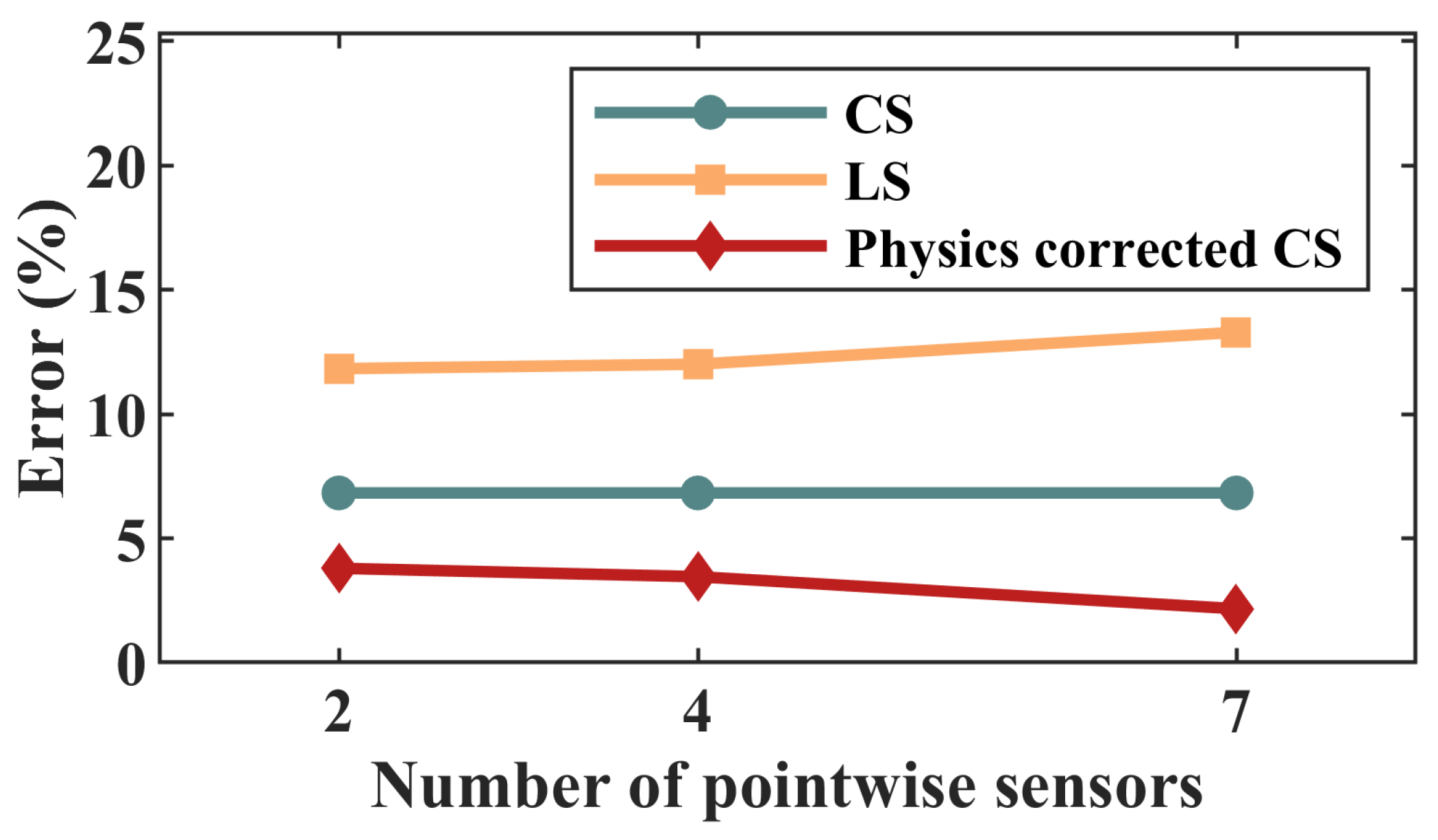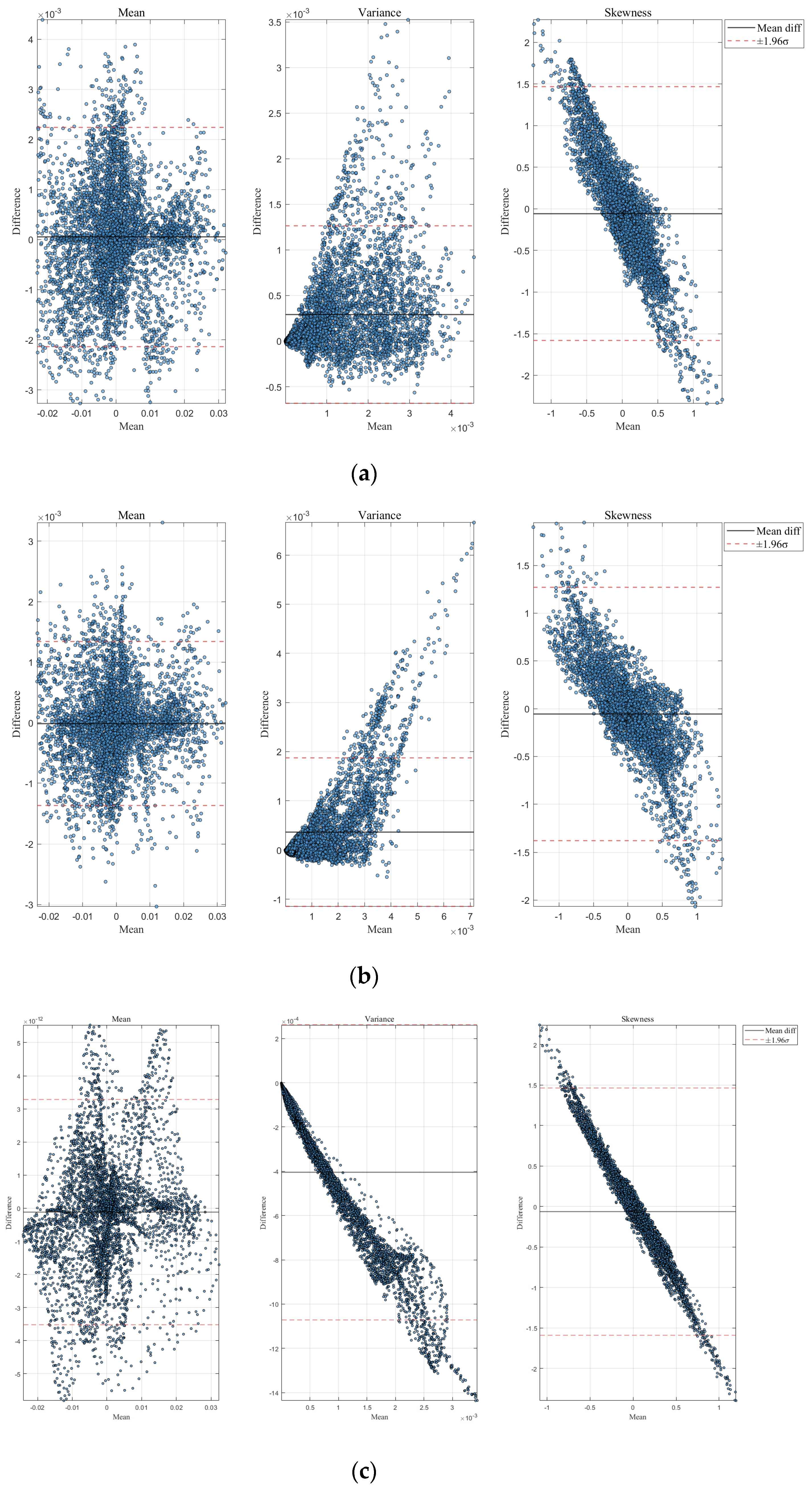3.1. Method Validation on a Benchmark Case (Re = 100)
To rigorously verify the effectiveness of the proposed PCCS method and to benchmark its performance against the classical LSE and standard CS approaches, this study adopts the canonical two-dimensional flow past a circular cylinder at Re = 100 as the baseline validation case (see
Section 2.5). This configuration exhibits a clearly defined vortex-shedding pattern and has been widely used for quantitative validation of modal decomposition and data-driven reconstruction techniques.
In order to quantitatively assess each method’s ability to recover the flow’s unsteady frequency content, we first compute the power spectral density (PSD) of the reconstructed velocity signals (e.g., the fluctuating velocity components) at key locations and compare them with the true PSD. After converting the PSD to a logarithmic scale (dB), we further define the principal error metric for PSD reconstruction accuracy—the Mean Absolute dB Error (MADE)—as follows:
Here, is the total number of frequency points considered, denotes the power-spectral density reconstructed by each method, and represents the power-spectral density obtained from the DNS ground truth.
Moreover, this study also evaluates each method’s accuracy in reconstructing the spatial statistical features of the flow field—including the full-field relative errors of the first-order moment (mean), the second-order moment (variance), and the third-order moment (skewness)—using the following formulas:
Meanwhile, is the spatial average of the k-th statistical moment of the velocity field.
Table 1 summarizes the PSD error comparison and statistical moment errors for the LSE, CS, and PCCS methods in the benchmark case. The PCCS method achieves a MADE of only 0.71 dB, which is substantially lower than the 2.59 dB of CS and the 3.81 dB of LSE, demonstrating that PCCS effectively suppresses the spurious high-frequency fluctuations exhibited by CS and avoids the underestimation of true spectral features characteristic of LSE.
The statistical moment error results further underscore PCCS’s superiority: the full-field first-order moment error is 0.6% (LSE: 25.67%, CS: 0.93%), the second-order moment error is 1.78% (LSE: 8.49%, CS: 8.27%), and the third-order moment error is 29.73% (LSE: 135.30%, CS: 54.49%), all markedly better than those obtained with the other two methods.
For a comprehensive assessment of the reconstruction performance of LSE, CS, and PCCS on non-periodic, broadband flows, this section uses the transverse velocity fluctuation component in the two-dimensional flow past a circular cylinder at Re = 100 as the benchmark and presents side-by-side comparisons in three aspects: instantaneous flow fields, spatial distributions of statistical-moment error fields, and spectral recovery.
As shown in
Figure 3, the instantaneous cross-sectional contours of the transverse velocity reconstructed by each method are displayed: LSE (
Figure 3a): At the probe locations, LSE accurately fits the point-measurement data; however, due to the sparsity of probes, the spatial distribution is markedly fragmented and fails to capture the continuous vortex structures on either side of the wake. CS (
Figure 3b): While CS better reproduces the overall shedding band in the full-field contour, the reconstruction is contaminated by abundant high-frequency noise, producing spurious local structures. PCCS (
Figure 3c): PCCS closely matches the DNS ground truth in both spatial detail and amplitude distribution, faithfully reconstructing the primary vortex-shedding region while suppressing the high-frequency artefacts present in the CS result.
Figure 4 compares the full-field relative error distributions for the first-order moment (mean), second-order moment (variance), and third-order moment (skewness): First-order moment error: LSE shows large mean-velocity deviations on either side of the shedding region; CS exhibits smaller overall bias but fluctuating errors along the shear-layer lines; PCCS confines the first-moment error to near 0%, with virtually no discernible bias. Second-order moment error: LSE severely underestimates variance along the wake centerline; CS introduces roughly 5% spurious oscillations in high-frequency zones; PCCS limits variance error to a low level of 1–2%. Third-order moment error: Since skewness is highly sensitive to higher-order statistics, both LSE and CS incur large errors at the edges of the wake structures, whereas PCCS effectively suppresses skewness error, thereby better preserving the flow’s asymmetry.
Figure 5 presents the reconstructed power spectral density (PSD) of the spatially averaged velocity fluctuation signal: LSE (
Figure 5a): Significantly underestimates high-frequency energy above the shedding peak, causing the PSD curve to drop sharply in the mid-to-high-frequency range. CS (
Figure 5b): Recovers more high-frequency components but introduces discrete spurious peaks and nonphysical spectral noise. PCCS (
Figure 5c): Maintains excellent agreement with the true spectrum across the entire frequency range, accurately restoring the primary spectral peak amplitude while suppressing the CS-induced high-frequency artefacts. The mean absolute dB error (MADE) for PCCS is computed as only 0.71 dB, compared to 2.59 dB for CS and 3.81 dB for LSE.
In summary, by incorporating point-measurement constraints on high-frequency content, the PCCS method not only fully recovers instantaneous vortex-shedding structures but also achieves substantial improvements over traditional LSE and pure CS in both spatial statistical moments and spectral fidelity, thereby demonstrating its superior capability for reconstructing non-periodic, multi-frequency flows with enhanced spatiotemporal resolution.
3.2. Application to Ccomplex Wake: Tandem Cylinders (Re ≈ 103)
The measurement matrix corresponds to the sampling algorithm in PIV. POD analysis is first applied to the down sampled 591 snapshots, whose smallest interval between two adjacent snapshots is bigger than 0.25 s. In view of the modes decomposed by POD that are used to accomplish a reconstruction, the average flow field is included in modes. The variance spectrum and POD modes are presented in
Figure 6. It is obvious that only the first mode, also meaning the average flow, is the dominating one, which contributes approximately 79% of the total fluctuating energy, as
Figure 6a depicted. A sum of 100 modes consume about 98% fluctuating variance and higher-order modes still contribute little energy due to the turbulence in the flow. The first three modes are shown in
Figure 6b: the average wake flow is on the left, the second mode in the middle, and the third mode on the right. Vortex structures are concentrated in the wake of big cylinder in captured the second and third modes. In this article, the first 100 modes are employed in the following reconstruction implementation.
Figure 7 compares the DCT coefficients reconstructed using CS, LS, and data fusion CS methods. The distribution of DCT coefficients across the
x-axis reflects the frequency information from lower to higher bands [
23]. From the ground truth time-resolved data in
Figure 7a, it is obvious that DCT coefficients are sparse, indicating a feasibility using CS reconstruction. However, as shown in
Figure 7b, the CS reconstruction from down-sampled PIV data is remarkably deviated from the ground truth values. This phenomenon can be explained by congenital defects of BP algorithm. Though BP algorithm can provide a higher accuracy,
-norm cannot distinguish the location of the sparse coefficients scale and is thus prone to some artificial effects, namely transfers from low-scale energy to high-scale energy. On the other hand, the LS reconstruction from pointwise time-resolved data, as a
-norm solution, can remedy the disadvantage in high-frequency noise. However, the LS cannot precisely detect the non-zero values in the DCT spectrum. Therefore, the data fusion method applies LS results as the upper and lower bounds on the DCT coefficients calculated from the CS solution. This approach significantly enhances the accuracy of the DCT coefficients compared to using the CS and LS methods separately.
The reconstructed POD coefficients from the DCT spectrum are compared in
Figure 8. The temporal resolution is significantly improved.
Figure 8a presents the coefficients in short-time period to show the details, whereas
Figure 8b-e presents the coefficients in a long-time period. The down-sampled points are marked by the blue stars in
Figure 8a. In the short-time period, the CS reconstruction from down-sampled PIV data clearly has strong noise compared to the ground truth. The LS method based on pointwise time-resolved data can depress the noise, but the calculated values deviate from the ground-truth data remarkably. As a contrast, the data fusion CS can more faithfully reconstruct the temporal coefficients with much less noise. The comparison is more obvious for the long-time period, as shown in
Figure 8b–e.
However, the reconstructed POD coefficients demonstrated above obey the Nyquist sampling algorithm. POD coefficients corresponding to the fifth mode are an example of sub-sampling and the reconstruction results are shown in the following parts. Likewise, DCT coefficients, as shown in
Figure 9, are first given to compare the reconstruction results via CS, LS and PCCS, respectively. The left parts, as showed before, represent the DCT coefficients in long data sequences and the right parts are short data sequences to amplify the non-zero parts. Remarkable deviations for CS from the ground-truth data exist in both high-frequency parts and low-frequency parts, which can also be explained by the artificial effects of
-norm. LS reconstruction, like before, loses the value accuracy but detects the existence of the frequency variance with a relatively accuracy. The PCCS, as
Figure 9d showed, combines the advantages of both CS and LS, overcoming the energy transfer and inaccuracy in low-frequency parts at the same time. However, it is well-known that low-frequency parts contain more information than high-frequency parts for low-frequency parts reflect the outline of signals. Therefore, the inaccuracy is acceptable.
Figure 10 gives a comparison for the reconstructed POD coefficients between ground-truth, CS, LS, and PCCS. The coefficients corresponding to the sampled snapshots are also marked by the blue stars in
Figure 10a. In a short time series, it is obvious that there exists a great deal of high-frequency fluctuations for CS reconstruction, as indicated by
Figure 7a. In addition, the reconstructed values seem higher than the ground-truth data on the whole. The reconstructed POD coefficients by LS regression, however, deviates from the ground-truth data remarkably, which is in accordance with the result of DCT coefficients. As a contrast, PCCS reconstruction has only very slight fluctuations around the ground-truth data and has an accurate outline fitting the ground-truth curve. In a longer time series, the reconstruction performance is clearer, as shown in
Figure 10b–e. Characterizing a fuzzy outline of the ground-truth data, CS reconstruction seems provide an approximation to real coefficients, presenting a similar result as the reconstructed data before. Too many high-frequency fluctuations around real data are unable to be neglected, which indicates a low reconstruction accuracy. The LS reconstructed data, like before, lose the essential features of the original data. As a sharp contrast, PCCS provides an almost perfect approximation in a manner of speaking.
Based on the reconstructed POD coefficients, the time-resolved flow field snapshots are obtained and compared with the ground truth in
Figure 11.
Figure 11 compares representative reconstructed flow field snapshots against the ground truth. Notably, the snapshots shown are taken at times that were not directly captured by PIV (i.e., intermediate time steps), demonstrating the PCCS method’s ability to produce high-temporal-resolution flow fields beyond the original sampling instants. Consistent with the frequency-domain findings, the CS-only reconstruction captures the overall wake pattern but fails to reproduce finer spatial details due to spurious high-frequency noise. The LS-only reconstruction is even worse, yielding unphysical, discrete flow features because the very limited pointwise data cannot represent the continuous spatial structures or the overall trend of the flow. In contrast, the PCCS reconstruction preserves both the global flow pattern and the local flow details with high fidelity, producing snapshots whose vortex structures and velocity magnitudes closely match the ground truth. This highlights the method’s superior spatial and temporal reconstruction accuracy compared to the other approaches.
The number of probes is then reduced to compare the reconstruction performance, as depicted in
Figure 12, which is described in a long time series corresponding to mode 5.
Figure 10a–d corresponds to employing seven probes, four probes and two probes, respectively. It is clear that the fitting becomes poorer when the number of probes is reduced gradually, appearing as more high-frequency noise and error values. However, though the reconstruction performance when employing two probes turns down compared to employing seven probes, PCCS is still a strong performer compared to CS and LS, as shown in
Figure 10c,d.
To precisely illustrate the accuracy of the reconstructed data, the error, defined by comparing the recovered and ground-truth data, was calculated using the following relation prescribed by Ruscher et al. [
24], as follows:
where
represents the reconstructed velocity at spatial location
, while
denotes the corresponding ground-truth velocity. The variables
and
denote maximum and minimum values in whole 25,000 snapshots, respectively, across the entire region. The error for every snapshot is then calculated by averaging the errors in all locations and the final error shown in
Figure 13 is the average value for all the reconstructed snapshots avoiding the sampled data. It is noted that the probes are not required in CS reconstruction while both LS and PCCS need to employ pointwise sensors. In order to give an intuitive error contrast, CS reconstruction error is figured on the same picture. Obviously, no matter employing two probes or four probes or seven probes, PCCS reconstruction has a higher accuracy than CS reconstruction and LS reconstruction. With the number of sensors increasing, PCCS reconstruction has a better performance while LS is on the contrary.
The study additionally computes the power-spectral density (PSD) and defines the mean absolute deviation in energy (MADE) in decibel units. Furthermore, the global L2-norm errors between the reconstructed and reference fields are evaluated for the first-, second-, and third-order moments—mean, variance, and skewness—to provide a more comprehensive quantification of each method’s ability to capture the multi-frequency, aperiodic characteristics of the flow
Table 2 summarizes the percentage errors of the three methods for the first-, second-, and third-order moments. PCCS attains the lowest errors, 2.6%, 26.66%, and 45.39%, respectively, markedly outperforming both CS and LSE.
In
Figure 14, the power-spectral–density (PSD) curves of the spatially averaged fluctuating-velocity signal are compared. As shown in
Figure 14a, the LSE method satisfactorily reconstructs the large-scale, low-frequency structures yet fails to recover the high-frequency turbulent content. The CS approach (
Figure 14b) reproduces the dominant frequency reasonably well but cannot suppress the spurious high-frequency components. By contrast, the PCCS solution (
Figure 14c) aligns almost perfectly with the DNS reference over the entire spectral range, accurately capturing the principal vortex-shedding frequency while effectively eliminating the high-frequency artefacts introduced by CS. In terms of the mean absolute deviation in energy (MADE), LSE yields 7.9 dB and CS suffers from large errors in the high-frequency band, whereas PCCS records only 0.9 dB, exhibiting markedly higher accuracy than both LSE and CS.
Figure 15 compares the spatial distributions of the relative errors in the first- (mean), second- (variance), and third-order (skewness) moments obtained with the three reconstruction techniques.
As illustrated in
Figure 15a, the LSE approach displays a markedly higher relative error, revealing its inability to capture small-scale, high-frequency features during reconstruction. By contrast, the CS method (
Figure 15b) lowers the overall error substantially, indicating that the sparsity-promoting strategy effectively suppresses global discrepancies, although localized peaks remain evident. The PCCS technique (
Figure 15c) produces a dense cluster of points confined to a narrow band around the zero-difference line and exhibits the tightest confidence limits, demonstrating well-controlled errors. These observations collectively substantiate the superiority of PCCS in recovering the spatiotemporal resolution of the flow field.




